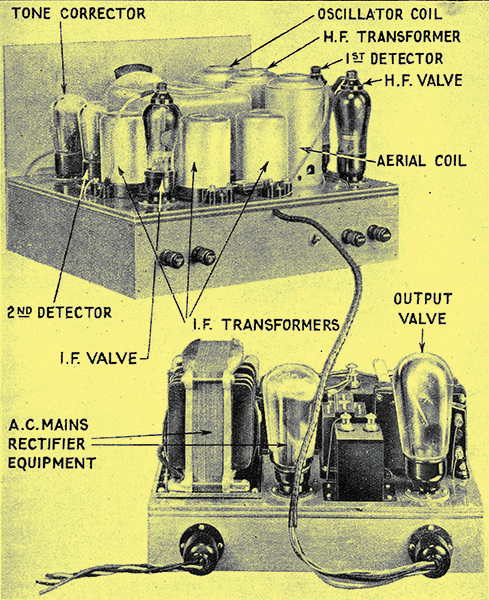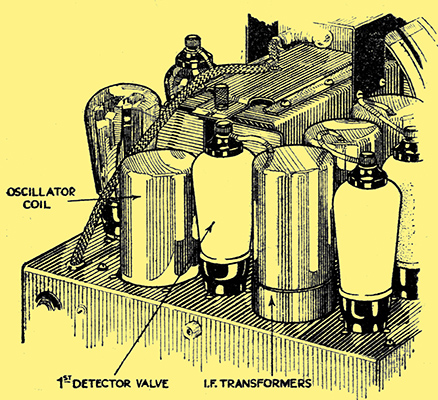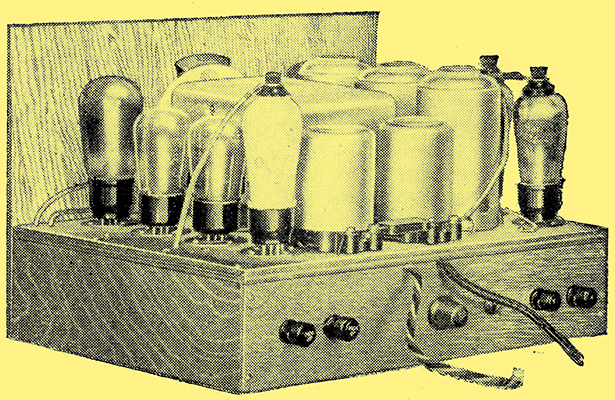|
In this series of articles the path of the signal through the circuits of the superheterodyne receiver is explained stage by stage.

Illustration of a typical superhet, The Wireless World Monodial, with the various parts identified.
Perhaps the most baffling phenomenon associated with the superheterodyne is the incidence of whistles, which are sometimes erroneously attributed to instability. As a superhet must be judged partly by its freedom from whistles, it is essential that the designer should comprehend their cause and cure.
It has so far been assumed that the intermediate frequency has a value of 110 kHz, but it will be obvious that any desired frequency could be employed, and it is necessary to justify our choice. The intermediate frequency is equal to the difference between the frequencies of the oscillator and of the incoming signal. There are, therefore, two different oscillator frequencies which will permit the intermediate frequency to be obtained for any signal, and there may be two different signals transferred to the intermediate frequency for any oscillator frequency.
This will be readily apparent, for to receive a station on 1,000 kHz, the oscillator can be set to either 1,110 kHz or to 890 kHz, since in each case the difference between the oscillator and the signal frequencies is 110 kHz. Using the 1,110 kHz oscillator frequency to beat with the 1,000 kHz signal, it is equally apparent that a station on 1,220 kHz will also beat with the oscillator to provide the intermediate frequency.
This is the phenomenon known as second channel interference, and in modern single control superheterodynes the station causing the interference is always higher in frequency than the wanted station by twice the intermediate frequency. Selectivity in the IF circuits will do nothing whatever to reduce second channel interference; the selectivity necessary for combating the evil must occur before the first detector. In order to avoid second channel interference it is necessary merely that the pre-selector circuits should give large discrimination between the wanted station and one on a frequency higher by twice the intermediate frequency. Not only the intrinsic selectivity of the signal frequency circuits must be taken into consideration, therefore, but also the relative initial intensities of the stations, and the value of the intermediate frequency.
It will be apparent that the higher the intermediate frequency we choose the less will second channel interference be evident with preselector circuits of given efficiency, for the higher the intermediate frequency the further away from resonance will be the station causing second channel interference. It has already been pointed out, however, that a low intermediate frequency is desirable from the point of view of adjacent channel selectivity.
The selectivity of a tuned circuit depends not only upon the efficiency of that circuit itself, but upon the percentage difference from resonance of an interfering signal. If we choose an intermediate frequency of 25 kHz it will reject a station on 35 kHz, 10 kHz off tune, with the same ease that a circuit of equal intrinsic efficiency will reject a station on 140 kHz if it be tuned to 100 kHz, or 1,400 kHz if it be tuned to 1,000 kHz. In each case the percentage frequency difference remains the same, but the actual frequency difference gets smaller and smaller as the intermediate frequency is reduced. Since stations are spaced on the basis of a constant frequency separation the advantages of using a low intermediate frequency are readily apparent.
From the point of view of adjacent channel selectivity, therefore, we should like to choose as low an intermediate frequency as possible, whereas the other extreme is desirable as regards second channel interference. There are other limitations, however; for the frequency can hardly be within the range of frequencies to be received, and it is not advisable that it approach it too closely, nor must it be near the audible range. In general, therefore, the frequency chosen must be higher than 1,600 kHz, between 500 kHz and 450 kHz, or between 130 kHz and 25 kHz.
Choosing the IF

Part of the 'Alba' set in which second channel interference is avoided by the use of an IF frequency of 473 kHz.
The chief advantage of the superheterodyne in providing high selectivity is lost if the intermediate frequency be higher than the signal frequency, so that we rule out the use of frequencies higher than 1,600 kHz. We also pass by the 450/500 kHz possibility for normal requirements, since this is higher than the long-wave range; its use, however, is by no means impossible, and in special cases it might be desirable. In general, therefore, we must make our choice in the 25/130 kHz band, and at first we should be inclined to compromise on a mean frequency of some 87 kHz, but we have not yet considered every factor.
The phenomenon of beat interference has already been dealt with by the present writer [★] The Selectivity of the Superheterodyne. The Wireless World, May 13 and 20, 1931. and it was shown that if the signal frequency circuits be tuned to a station spaced from the local by an amount equal to the intermediate frequency, that station and the local could be received together, even in the absence of the oscillator. This, of course, is provided that the preselector circuits are not selective enough to prevent the local from setting up an appreciable voltage at the first detector. The local station, in fact, acts as an oscillator to heterodyne certain stations to the intermediate frequency.
The effect can be prevented in the same way as second channel interference, by making the pre-selector circuits give enough selectivity, and, in general, this is the only remedy. Even if the effect does occur, however, it is only on stations spaced from the local by the intermediate frequency, so that it may not be serious. Should there be two local stations, however, spaced by the intermediate frequency, then it is possible for audible interference due to their beats to occur over a large portion of the tuning range. It is important, therefore, to select an intermediate frequency which is not equal to the difference between the frequencies of any two nearby stations.
Effect of Harmonics
The two London stations are spaced by 304 kHz the two North stations by 370 kHz, and the two Scottish stations by 243 kHz, so that none of these is likely to cause any trouble. The Midland Regional, however, is separated from the London Regional by 91 kHz, and, although the stations are some distance apart, there are places where they are both receivable at a strength sufficient for beat interference to occur. We should, therefore, not choose an intermediate frequency between about 81 kHz and 101 kHz. The Midland Regional and the North Regional are separated by 127 kHz, so that it is wise not to select a frequency between 117 kHz and 137 kHz. A frequency lower than 80 kHz is hardly practicable on account of second channel interference, so that we find that we must choose in the 101 kHz to 117 kHz range. Here there is very little choice, and we are practically forced to 110 kHz. It is on this account that this frequency has been standardised by The Wireless World, and it may be said that practical results have entirely justified the choice.
Second channel interference, therefore, may occur when receiving a station 220 kHz lower in frequency than the local, and beat interference is possible when receiving a station 110 kHz higher or lower than the local. There are other possibilities of whistles, however, for consider the case when we receive a station 165 kHz lower than the local. The oscillator will then be working on a frequency 55 kHz lower than that of the local station, and if this sets up a voltage on the first detector grid a beat frequency of 55 kHz will be formed. If the first detector is not effectively linear, harmonics will be present, and the second harmonic of 55 kHz is 110 kHz, the intermediate frequency. If either the preselection is insufficient, or the first detector is non linear, therefore, whistles may be found whenever a station is received for which the oscillator must be set on either side of the local by 55 kHz, 36.3 kHz, 27.5 kHz, and so on.
Even this does not exhaust the possible whistles, for harmonics of the oscillator, and harmonics of the signals, produced by overloading the HF valve, can account for many more. The writer has calculated that, taking into account harmonics up to the fifth, a superheterodyne used close to Brookmans Park can give a whistle which is due initially to those stations on over 90 distant transmitters. If one local closed down one half of the whistles would disappear; if both stations closed down they would all vanish.
In practice, of course, it is rare for the trouble to occur with such magnitude. Their possibilities should be borne in mind, however, for the writer has actually handled a receiver in which every one of the calculated whistles appeared. The calculation, in fact, was undertaken in an endeavour to account for them, since previously it was not thought that so many were possible. Needless to say, the receiver in question was of poor design.
It should be emphasised that whistles are quite rare in a properly designed receiver, and there should never be more than perhaps four points at which such interference is found. Even these can be removed, but, as they do not represent serious interference, it is not always economical to include the extra circuits which would be needed. Good initial design, and the correct adjustment of the receiver, are all that is necessary to avoid the trouble. The importance of correct adjustment can hardly be overstressed, for the intrinsic merit of a design can be completely ruined by maladjustment of the circuits.

If whistles are to be avoided in a superhet with single dial control, careful choice must be made of the pre-selector circuits, the IF frequency, and the HF valves. This illustration shows the essential components associated with the frequency changer.
Second channel and beat interference can be avoided only by the use of a suitable pre-selector system, but while this remedy is applicable also to the various forms of harmonic interference, these can also be avoided by the use of a first detector which is effectively linear. Since such a characteristic is necessary to avoid distortion in frequency changing, it would naturally be used. One must guard against overloading the first detector, however, for the first symptom of this would normally be the appearance of whistles rather than of noticeable distortion.
Avoid Overloading
Under the majority of ordinary circumstances, two tuned circuits with screened air-core coils will provide sufficient selectivity for the avoidance of all but three or four whistles when the set is used on a good aerial within a few miles of modern twin-wave high-power stations. Under the same conditions, three tuned circuits will remove all whistles. It is necessary, however, that the first detector should be effectively linear, and that neither this valve nor the HF valve should be overloaded, otherwise many whistles will be found even with three tuned pre-selector circuits. The question of overloading is important, since if the receiver be used very close to at local station it may prove advisable to limit the size of the aerial; this is particularly likely to be the case when battery valves are used, since they will not handle such a large input as the mains types.
Although the receiver may include the necessary number of preselector circuits of the requisite efficiency, and the operating characteristics of the valves be adjusted to perfection, this will be of no avail unless the circuits are accurately ganged. In a straight set mis-ganging merely reduces the sensitivity and selectivity, and if it be slight it may pass unnoticed. In a superheterodyne the result is initially the same, but the reduction in the selectivity of the signal frequency circuits greatly increases any tendency for the generation of whistles, and these will certainly make themselves evident.
There is no difficulty in obtaining accurate ganging, provided that a suitable circuit be chosen and the receiver be correctly built. This matter, therefore, will be treated at length in the next part of this series of articles.

A popular constructional receiver - The Wireless World AVC Monodial AC Super in which an intermediate frequency of 110 kHz is used.
Series Contents
|